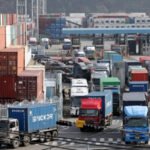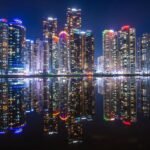Ancient Beginnings: The Founding of Busan
Busan, known as the second largest metropolitan city in South Korea, has a rich history that dates back to ancient times. The earliest recorded existence of Busan can be traced to the Goryeo Dynasty, where it was referenced as a vital coastal settlement. Its strategic location along the southeastern coast of the Korean Peninsula made it an essential hub for maritime trade, connecting various regions through its bustling port.
The establishment of Busan as a trading port can be attributed to its natural harbor, which provided a safe anchorage for ships. This feature facilitated commerce with neighboring nations, notably China and Japan, enabling the exchange of goods such as rice, ceramics, and textiles. Over the centuries, Busan emerged as a significant market for domestic and international trade, laying the groundwork for its future development.
Archaeological findings in the Busan region have unearthed various ancient artifacts that provide valuable insights into the early inhabitants’ culture and daily life. These artifacts, such as pottery and tools, suggest that the residents of Busan engaged not only in trade but also in agriculture and fishing, indicating a relatively self-sufficient society. Historical texts further illuminate the interactions between Busan and neighboring cultures, showcasing a rich tapestry of influences that shaped the region’s identity.
The significance of Busan as a coastal settlement cannot be overstated. It served as a conduit for cultural exchange and economic interaction, facilitating the assimilation of diverse traditions and practices. As a result, Busan’s founding marked the beginning of a vibrant community that would evolve over centuries, ultimately becoming a critical player in South Korea’s historical and economic landscape.
Busan During the Three Kingdoms Period
Busan’s historical significance began to take shape during the Three Kingdoms period (57 BC – 668 AD), a time when three rival kingdoms—Goguryeo, Baekje, and Silla—vied for control over the Korean peninsula. Among these, the Kingdom of Silla emerged as a dominant power in the southeastern region, with Busan serving as a strategically important hub. Located on the southeastern coast, Busan’s geography offered both military advantages and rich resources, making it a critical point for trade and defense strategies.
Throughout this era, Busan functioned as a military staging ground for Silla. Its coastal position allowed for efficient naval movements, enabling Silla to protect its territories against incursions from rival states. The city’s access to the sea facilitated commerce with neighboring regions, which further enhanced its significance in trade. Notably, the Busan area became known for its exports of local goods and imports from Japan and other areas, corroborating its role in maritime trade relations.
Central to this period were several influential figures who contributed to Busan’s development. One notable leader was King Munseong of Silla, who played a pivotal role in bolstering the city’s defenses and expanding its influence. Additionally, the establishment of fortifications around Busan proved essential for military endeavors, reflecting the city’s role as a buffer against invasions.
Furthermore, the cultural exchanges facilitated by trade routes through Busan enriched the local society and laid the groundwork for future advancements. The blending of cultures during this time can be seen in the archaeological remains and artifacts that continue to be unearthed today. Overall, Busan’s role during the Three Kingdoms period showcased its importance as a center of military power and trade, laying the foundation for its enduring legacy in South Korean history.
The Joseon Dynasty: Growth and Development
The Joseon Dynasty, which lasted from 1392 to 1910, marked a significant period in the history of Busan, transforming it into a dynamic commercial hub. During this era, the city’s strategic coastal location became increasingly important, paving the way for Busan to develop as a major port city. The establishment of the busan port facilitated trade with foreign nations, promoting economic growth and a cultural exchange that would shape the city’s identity.
In the early years of the Joseon Dynasty, Busan’s status as a trading post was cemented by the establishment of important institutions. Notable among these was the construction of the Dongnae (now part of Busan) area, which served as a vital administrative center. The area’s accessibility to shipping routes helped cultivate a flourishing market that attracted merchants from distant regions, particularly from Japan and China. This influx enabled Busan to evolve into an increasingly diverse community, enriched by various cultural influences that contributed to the city’s social tapestry.
Furthermore, the Joseon era saw the construction of numerous architectural landmarks that enhanced the cultural heritage of Busan. Prominent structures, including temples and pavilions, were erected, showcasing traditional Korean architecture and promoting regional pride. The most notable of these landmarks was the Beomeosa Temple, which continues to be a significant religious site today. As income from trade poured into the city, it fostered arts and education, leading to the establishment of Confucian schools that further advanced Busan’s intellectual pursuits.
Overall, the Joseon Dynasty cultivated an environment that allowed Busan to flourish economically and culturally, laying the foundations for its modern identity as a vibrant seaside metropolis. The combination of trade, institutional growth, and architectural development during this period was vital in establishing Busan’s reputation as a key player in the region.
Colonial Era: Transformations Under Japanese Rule
The period of Japanese colonial rule from 1910 to 1945 marked a significant transformation for Busan, South Korea’s second largest metropolitan city. The Japanese administration focused on developing infrastructure and enhancing economic activities in the region, aiming to integrate Busan into the broader imperial network. One of the most notable developments during this era was the expansion of the port, which became a crucial hub for trade and transportation. This strategic enhancement positioned Busan as a primary gateway for both exporting goods and importing products, facilitating a shift in the local economy.
Additionally, the construction of railroads played a key role in connecting Busan with other parts of Korea. The establishment of efficient rail links significantly boosted trade, enabling the swift movement of commodities and passengers. These advancements not only increased the flow of resources but also promoted urban migration, as many individuals sought better opportunities in the burgeoning city. However, this rapid development did not come without challenges. Local residents faced a variety of social issues, including economic exploitation and cultural suppression. The Japanese authorities often imposed strict controls on free expression and sought to diminish Korean cultural identity, resulting in a strained relationship between the occupiers and the local populace.
The impact of this colonial period was profound and lasting. The infrastructural improvements, while beneficial in some respects, also entrenched a legacy of economic disparity and social upheaval. Challenges created during these years would later influence the post-war recovery and development of Busan, contributing to the complexity of its historical narrative. As the city navigated the dual legacies of colonial modernization and resistance, the experiences of the residents during this era became a formative chapter in Busan’s evolution.
Post-War Reconstruction and the Rise of Industry
Following the tumultuous years of the Korean War from 1950 to 1953, Busan emerged from the ashes of conflict as a beacon of resilience and transformation. The city’s strategic coastal location made it a crucial site for post-war reconstruction efforts, attracting both governmental support and international aid, particularly from the United States. This support was instrumental in revitalizing Busan’s economy, leading to significant investments in infrastructure and housing, which laid the foundation for rapid urban growth.
During the post-war era, the South Korean government initiated a series of economic policies aimed at fostering industrial development. Busan quickly became a focal point for manufacturing due to its natural harbor, which facilitated trade. The establishment of numerous factories attracted a workforce eager for employment, significantly altering the demographic landscape. As a result, the city witnessed a migration of rural populations, seeking better opportunities in the burgeoning industrial sector. This influx contributed to an urban culture that not only embraced industry but also coped with the challenges of rapid population growth.
In addition to domestic efforts, international influences played a pivotal role in Busan’s transformation. Many multinational companies began to establish operations in the region, attracted by the potential for low labor costs and access to emerging markets. This foreign investment catalyzed technological advancements and modernized production techniques, allowing Busan to become a key player in the global manufacturing arena. As a consequence, the city steadily diversified its industrial base, moving beyond textiles and food production to include shipbuilding, electronics, and petrochemicals, solidifying its position as a major metropolitan hub in South Korea.
Through this rigorous process of reconstruction and adaptation, Busan evolved into a vibrant industrial city. The intertwining of local determination and international collaboration not only propelled its economic growth but also reshaped its social fabric, forging a distinct identity that persists to this day.
Busan in the Modern Era: A Cultural Metropolis
Since the late 20th century, Busan has undergone a remarkable transformation, evolving into a vibrant cultural metropolis that attracts visitors from around the globe. This evolution is characterized by the city’s commitment to promoting its unique heritage and fostering artistic expression through various cultural initiatives. Most notably, Busan is recognized for its dynamic film industry, which has gained international acclaim, particularly through the Busan International Film Festival (BIFF). Established in 1996, BIFF has grown into Asia’s premier film festival, showcasing a diverse array of films from around the world and providing a platform for filmmakers to connect with audiences.
In addition to the film festival, Busan’s cultural landscape is enriched by numerous other events and festivities that celebrate both local and global traditions. The city hosts the Busan Sea Festival, which attracts thousands of visitors each year, and the Busan Art Fair, which highlights contemporary artworks from emerging and established artists. These events not only enhance the city’s reputation as a cultural hub but also stimulate economic growth through tourism and the creative industries.
Furthermore, Busan’s beautiful coastal scenery, with its stunning beaches and picturesque landscapes, plays a significant role in its appeal as a tourist destination. The city’s blend of traditional and modern architecture, such as the iconic Jagalchi Fish Market alongside the contemporary Busan Cinema Center, reflects its rich history while embracing modernity. This juxtaposition of old and new further enhances Busan’s allure, making it a must-visit cultural destination.
The city’s infrastructural developments, including the expansion of public transportation and upgrades to tourist facilities, have also contributed to its recognition as a major metropolitan area. As the cultural heart of South Korea, Busan continues to solidify its position on the global stage, fostering artistic innovations and celebrating its unique identity while welcoming a diverse array of visitors.
Sustainable Development: Challenges and Opportunities
The rapid urbanization of Busan, South Korea’s second-largest metropolitan city, poses significant challenges to sustainable development. With a population exceeding 3.4 million, the city grapples with pressing issues such as environmental degradation, traffic congestion, and energy consumption. The interplay between urban expansion and ecological sustainability underscores the urgency for effective policies and community-driven solutions.
One of the foremost challenges Busan faces is the management of waste and pollutants resulting from increased industrial activities and a growing urban populace. Both air and water quality have come under scrutiny, prompting governmental agencies to develop strict environmental regulations and action plans to mitigate these issues. In recent years, busan’s local government has introduced several initiatives aimed at reducing carbon emissions, including enhancing public transportation infrastructure and encouraging the use of electric vehicles. These initiatives not only aim to lower the environmental impact but also to promote a healthier urban ecosystem.
Community engagement plays a pivotal role in fostering sustainable urban development in Busan. Citizens have begun to participate actively in ecological conservation projects, such as tree planting campaigns and clean-up drives along the coastlines. Local organizations and NGOs work collaboratively with the government to raise awareness about the importance of sustainability, thereby cultivating a culture of environmental stewardship. Importantly, these community-driven efforts have been instrumental in generating public support for innovative policies aimed at sustainable urban planning.
Moreover, Busan is exploring renewable energy solutions, including solar and wind energy, to diversify its energy sources and reduce reliance on fossil fuels. Government investments in smart city technologies aim to improve energy efficiency and resource management effectively. These opportunities for sustainable growth reveal a multifaceted approach to urban sustainability, integrating technology, policy, and community engagement to confront future challenges and build resilience.
The Future of Busan: Vision and Prospects
As Busan moves forward, its vision for the future encompasses innovative urban development projects and economic strategies aimed at fostering sustainable growth. The city’s aspirations to evolve into a smart city are at the forefront of its plans. With a focus on improving the quality of life for its residents, Busan aims to enhance public services through the integration of advanced technology and sustainable practices.
One of the key elements of Busan’s future development is the implementation of smart city initiatives that leverage technology to create smarter infrastructure. This incorporates the use of Internet of Things (IoT) devices to monitor and manage resources effectively. For instance, smart traffic management systems are being designed to reduce congestion while improving air quality. Additionally, the integration of renewable energy sources into the urban fabric aligns with global sustainability goals, ultimately making Busan an eco-friendlier place to live.
In terms of economic strategies, Busan is positioning itself to attract foreign investment and boost local industries. The city is actively enhancing its port facilities, which are crucial for facilitating international trade. Plans are underway to develop logistics centers that will increase efficiency and solidify Busan’s status as a key maritime hub in Asia. Furthermore, initiatives aimed at promoting tourism are also set to enhance the local economy, capitalizing on Busan’s rich cultural heritage and scenic landscapes.
International cooperation is also an essential pillar of Busan’s vision for the future. By fostering partnerships with other cities and countries, Busan aims to share best practices in urban development and technology integration. This collaborative approach will undoubtedly facilitate the city’s transformation and pave the way for a prosperous, resilient Busan in the years to come.
Busan’s Place in Global Context
In recent decades, Busan has solidified its position as a significant player on the global stage. As South Korea’s second-largest metropolitan city, it has developed a robust economy driven by a diverse array of sectors, including manufacturing, services, and tourism. One of the key factors that has contributed to Busan’s prominence is its strategic geographic location as a major port city. The Port of Busan is the largest in South Korea and among the busiest in the world, facilitating vital international trade and establishing Busan as a critical logistics hub within the Asia-Pacific region.
Busan’s trade partnerships are varied and impactful, encompassing relationships with countries such as China, Japan, the United States, and members of the ASEAN community. Owing to these partnerships, the city has nurtured a dynamic export-driven economy, exporting textiles, electronics, and automobiles, among other goods. Furthermore, Busan has actively participated in various international events, including the Busan International Film Festival (BIFF) and the Busan International Maritime Festival, which not only highlight its cultural significance but also attract global attention and business opportunities.
The city’s commitment to building its international profile is evident in its efforts to enhance diplomatic ties and increase foreign investments. Recent initiatives have aimed to promote Busan as an attractive destination for global businesses and foreign tourists, showcasing its cultural heritage and modern infrastructure. Additionally, the city has positioned itself as a center for innovation and technology, fostering collaboration with global tech companies and startups to remain competitive in today’s fast-paced economy.
In conclusion, as Busan continues to leverage its historical significance alongside modern developments, it stands poised to elevate its global stature further. By strengthening international relations and trade partnerships, while embracing innovation, Busan is likely to sustain its relevance and prominence in the global arena for years to come.















